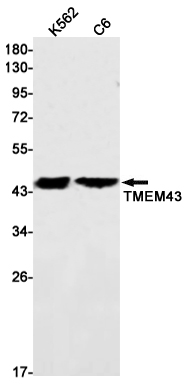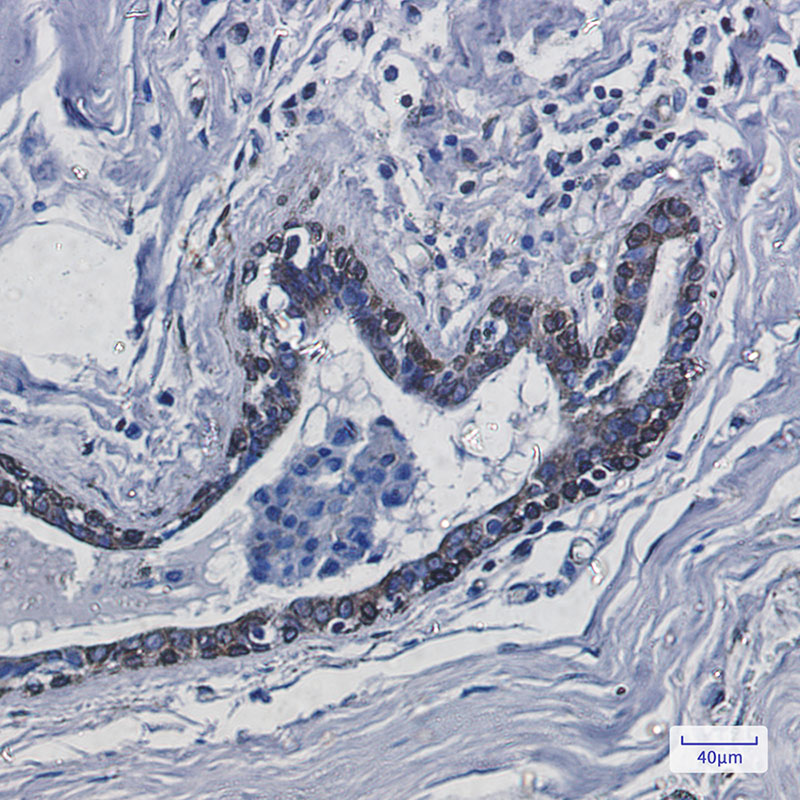

| WB | 1/500-1/1000 | Human,Mouse,Rat |
| IF | 咨询技术 | Human,Mouse,Rat |
| IHC | 1/50-1/100 | Human,Mouse,Rat |
| ICC | 技术咨询 | Human,Mouse,Rat |
| FCM | 咨询技术 | Human,Mouse,Rat |
| Elisa | 咨询技术 | Human,Mouse,Rat |
| Aliases | LUMA; ARVC5; ARVD5; EDMD7 |
| Entrez GeneID | 79188 |
| WB Predicted band size | Calculated MW: 45 kDa; Observed MW: 45 kDa |
| Host/Isotype | Rabbit IgG |
| Antibody Type | Primary antibody |
| Storage | Store at 4°C short term. Aliquot and store at -20°C long term. Avoid freeze/thaw cycles. |
| Species Reactivity | Human,Rat |
| Immunogen | A synthetic peptide of human TMEM43 |
| Formulation | Purified antibody in TBS with 0.05% sodium azide,0.05%BSA and 50% glycerol. |
+ +
以下是3篇涉及TMEM43抗体的文献摘要信息,按研究领域分类整理:
1. **文献名称**: "Mutation in TMEM43 causes arrhythmogenic right ventricular cardiomyopathy"
**作者**: Merner ND, et al.
**摘要**: 该研究首次将TMEM43基因突变与致心律失常性右室心肌病(ARVC)关联,通过免疫组化实验使用TMEM43抗体证实该蛋白在心肌细胞核膜及间期的定位异常,揭示了其在细胞间连接中的潜在作用。
2. **文献名称**: "TMEM43 promotes pancreatic cancer progression by stabilizing PRPF3 and regulating RAP2B/ERK axis"
**作者**: Li Y, et al.
**摘要**: 研究利用TMEM43特异性抗体(购自Sigma-Aldrich,货号HPA038310)进行Western blot和免疫荧光实验,发现TMEM43通过调控PRPF3蛋白稳定性促进胰腺癌转移,并激活RAP2B/ERK信号通路。
3. **文献名称**: "TMEM43/LUMA is a key regulator of hepatic lipid metabolism"
**作者**: Gao X, et al.
**摘要**: 通过构建Tmem43敲除小鼠模型,结合兔源多克隆抗体(Abcam, ab129153)进行肝脏组织染色,证实TMEM43通过调节SREBP1通路影响脂质合成,其缺失导致脂肪肝表型。
---
**备注**:以上文献中提到的抗体多来源于商业公司(如Abcam、Sigma-Aldrich),实际引用时需根据实验需求验证抗体特异性。若需具体实验细节,建议检索PubMed或Web of Science时使用关键词“TMEM43 antibody”、“TMEM43 immunohistochemistry”进一步筛选。
Transmembrane Protein 43 (TMEM43), also known as ARVC5 or LUMA, is a ubiquitously expressed protein localized primarily in the nuclear envelope and endoplasmic reticulum. It plays critical roles in maintaining nuclear membrane stability, cell signaling, and cell adhesion. TMEM43 is characterized by multiple transmembrane domains, though its exact structure-function relationships remain under investigation. Notably, mutations in the TMEM43 gene, particularly the p.S358L variant, are strongly linked to arrhythmogenic right ventricular cardiomyopathy type 5 (ARVC5), a hereditary disorder affecting cardiac muscle integrity and electrical conduction.
Antibodies targeting TMEM43 are essential tools for studying its expression, localization, and interactions in both normal and pathological contexts. These antibodies are widely used in techniques like Western blotting, immunofluorescence, and immunohistochemistry to assess TMEM43 levels in tissues or cultured cells. Research applications include investigating its role in cardiac pathophysiology, nuclear envelope dynamics, and potential involvement in apoptosis or mechanical stress responses. Commercially available TMEM43 antibodies are typically raised against specific epitopes, such as cytoplasmic domains, and require validation for species reactivity (e.g., human, mouse) and assay compatibility. Their utility extends to diagnostic research for ARVC5 and mechanistic studies of TMEM43's interaction with partners like emerin and lamin A/C.
×